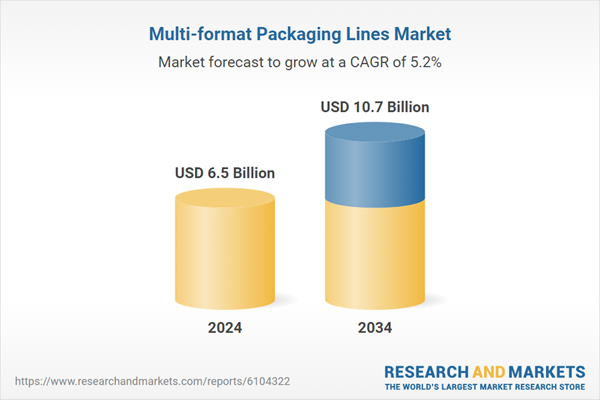Additionally, the competitive retail landscape has led brands to seek packaging solutions that can quickly respond to market demands and seasonal changes, further emphasizing the need for flexible packaging systems. This pressure to remain relevant and adaptive in real time has driven companies to prioritize packaging technologies capable of rapid format changeovers, minimal downtime, and multi-material handling.
As consumer trends evolve rapidly - whether due to holidays, promotions, limited editions, or regional preferences - brands are compelled to modify product appearance and format. Multi-format packaging lines enable manufacturers to execute these changes swiftly without compromising efficiency or cost control. This agility enhances shelf appeal but also supports diversified product portfolios aimed at capturing niche segments and maximizing brand visibility in a saturated marketplace.
The plastic packaging materials segment held a dominant share of USD 2.3 billion in 2024 and is forecasted to reach USD 3.5 billion by 2034. Their widespread application is largely attributed to their adaptability, strength, and lightweight properties, which make them suitable for a broad spectrum of packaging requirements. These materials continue to lead due to their compatibility with high-speed packaging lines and ability to be molded into various shapes and sizes, accommodating innovations in product presentation. Industries such as food and beverage, pharmaceuticals, personal care, and household goods rely heavily on plastics for packaging due to their extended shelf-life protection, tamper resistance, and low production cost.
The semi-automatic packaging lines segment held a market share of 36.7% in 2024 and is projected to grow at a CAGR of 6.8% through 2034. These systems are becoming increasingly favored due to their ability to offer both manual control and automated efficiency, creating a flexible production environment without the high costs associated with full automation. They are especially suitable for SME and contract manufacturers who require reliable, format-adaptable equipment that can be easily integrated into existing workflows.
United States Multi-Format Packaging Lines Market was valued at USD 920 million in 2024 and is projected to grow at a CAGR of 5.7% from 2025 to 2034. The U.S. leads the North American market due to its advanced manufacturing facilities, fully automated systems, and the significant presence of industries like food and beverage, personal care, and pharmaceuticals. The adoption of smart and flexible packaging technologies is driven by consumer demand for environmentally sustainable products and a diverse range of stock-keeping units (SKUs).
Key players in the Multi-Format Packaging Lines Industry include Fuji Machinery Co., Ltd., Bosch Packaging Technology (Syntegon), Coesia Group, Haver & Boecker, IMA Group, Ishida Co., Ltd., KHS GmbH, Marchesini Group, Multivac Group, ProMach Inc., Serac Group, Sidel Group, SIG Combibloc Group, and Tetra Pak. Companies in the multi-format packaging lines market are focusing on several strategies to strengthen their presence.
These include investing in research and development to create innovative packaging solutions that meet evolving consumer preferences. Partnerships and collaborations with other industry players are being pursued to expand product offerings and enter new markets. Additionally, companies are adopting sustainable practices by developing eco-friendly packaging materials and processes to align with increasing environmental concerns.
Comprehensive Market Analysis and Forecast
- Industry trends, key growth drivers, challenges, future opportunities, and regulatory landscape
- Competitive landscape with Porter’s Five Forces and PESTEL analysis
- Market size, segmentation, and regional forecasts
- In-depth company profiles, business strategies, financial insights, and SWOT analysis
This product will be delivered within 2-4 business days.
Table of Contents
COMPANIES MENTIONED
The companies featured in this multi-format packaging lines market report include:- Barry-Wehmiller Companies
- Bosch Packaging Technology (Syntegon)
- Coesia Group
- Fuji Machinery Co., Ltd.
- Haver & Boecker
- IMA Group
- Ishida Co., Ltd.
- KHS GmbH
- Marchesini Group
- Multivac Group
- ProMach Inc.
- Serac Group
- Sidel Group
- SIG Combibloc Group
- Tetra Pak
Table Information
| Report Attribute | Details |
|---|---|
| No. of Pages | 350 |
| Published | June 2025 |
| Forecast Period | 2024 - 2034 |
| Estimated Market Value ( USD | $ 6.5 Billion |
| Forecasted Market Value ( USD | $ 10.7 Billion |
| Compound Annual Growth Rate | 5.2% |
| Regions Covered | Global |
| No. of Companies Mentioned | 16 |









